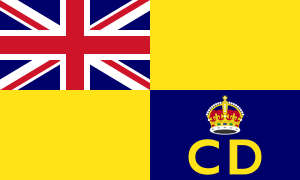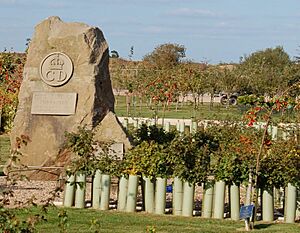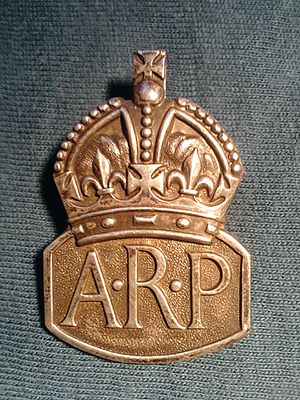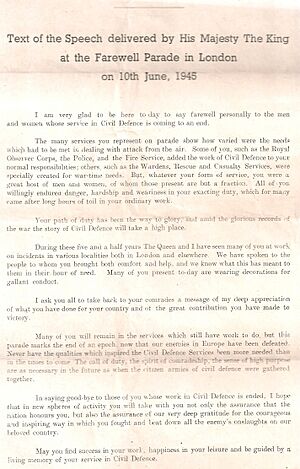Civil Defence Service facts for kids
Quick facts for kids Civil Defence Service |
|
|---|---|
 |
|
| Active | 1935–1945 |
| Country | |
| Type | Civilian volunteer organisation |
| Size | 1.9 million people total |
The Civil Defence Service was a group of everyday people who volunteered to help protect Great Britain during World War II. It started in 1935 as the Air Raid Precautions (ARP) and officially changed its name to the Civil Defence Service (CD) in 1941.
This service included many important roles. There were ARP Wardens, firefighters (from the Auxiliary Fire Service and later the National Fire Service), fire watchers, rescue teams, and first aid groups. More than 1.9 million people joined the CD, and sadly, almost 2,400 of them died while helping others during enemy attacks.
What the Civil Defence Service Did
Each local town or city was in charge of its own civil defence. Volunteers joined different teams based on their skills. Here are some of the main jobs they did:
Wardens: Local Heroes
Wardens were like the eyes and ears of their local areas. They would check for damage after air raids and report what they saw. They also helped guide people to safety, organized help, and told survivors where to find food and shelter. Some special wardens worked with police to manage big incidents.
Rescue Teams: Saving Lives
Rescue Parties had the tough job of going into buildings damaged by bombs. They would look for injured or trapped people and bring them out. They also turned off gas, electricity, and water to prevent more danger. Sometimes, they even had to fix or pull down unsafe buildings.
First Aid and Medical Help
Casualty services included first aid teams. These teams gave immediate medical help on the spot, much like today's emergency responders. They also helped people who might have been affected by gas attacks. If someone was badly hurt, they would be taken to first aid posts or hospitals by ambulance. Doctors and nurses would also go to bomb sites to treat serious injuries.
Gas Decontamination Teams: Cleaning Up
Gas Decontamination Teams wore special protective suits. Their job was to clean up buildings, roads, and other areas that had been hit by poisonous gas. They made sure these places were safe again for everyone.
Report and Control: The Nerve Centre
The Report and Control section was like the main control room. During an air raid, they received all the information about bombings. A controller at the local headquarters would then send rescue, medical, and decontamination teams to where they were needed. If a local area needed more help, the controller could ask for assistance from nearby towns.
Fire Guards: Watching for Flames
Fire Guards watched specific areas or buildings. Their main job was to spot incendiary bombs (bombs designed to start fires) and report any fires to the NFS. They could even put out small fires caused by single incendiary bombs using sand or water.
Welfare: Helping Those in Need
The Welfare teams supported people who were injured or whose homes were destroyed. They helped find new places for people to stay, gave out new ration books and identity cards, and provided money for food. They also set up rest centres for people who had lost their homes but were not injured.
Messengers: Delivering Vital News
Messengers were often teenagers, sometimes even scouts. They would ride bicycles to carry important messages from bomb sites back to the ARP headquarters. They usually had a bicycle, a steel helmet, and a gas mask.
The Women's Voluntary Service (WVS) also played a big part. They helped with ARP duties, acted as observers, and ran mobile canteens and rest centres.
Uniforms and Badges
At the very start of the war, ARP members didn't have uniforms. They wore their own clothes but were given helmets, armbands, and gas masks. Later, in 1939, wardens and rescue teams received blue cotton overalls. By 1941, all Civil Defence members were given dark blue uniforms, similar to military battledress, with a wool beret. If someone didn't get a full uniform, they wore a blue armband that said "Civil Defence."

Early ARP badges were made of silver. Later, they were made of a cheaper metal. Civil Defence members wore a round badge on their chest with the letters "CD" and a king's crown. A smaller version was worn on their beret.
Their shoulder badges showed which part of the service they belonged to. They could also wear badges if they were instructors or had special first aid training. Red stripes, called chevrons, were worn to show how long someone had served: one chevron for every 12 months.
Civil Defence members were given gas masks and steel helmets. The helmets were similar to those worn by soldiers but were often made to be less strong, as they weren't for frontline fighting. These helmets had small holes drilled in the rim to show they were not for military use. Letters on the helmets helped people quickly know what role someone had:
- W for wardens (some also had W/FG for warden/fire guard).
- R for rescue services.
- FAP for first aid parties.
- SP for stretcher parties.
- A for ambulance staff.
- M for messengers.
- MO for medical officers.
- RP for repair parties (like RP/G for gas repairs).
Fire Guard officers wore military helmets, while other Fire Guards wore Zuckerman helmets with "FG" written on them.
Disbanded
The Civil Defence Service officially ended on May 2, 1945, after the war was over. On June 10, 1945, King George VI thanked the volunteers in a special parade in Hyde Park. Many of the important duties carried out by the Civil Defence Service were later continued by the Civil Defence Corps, which started in 1949.
See also
- Air Raid Precautions
- Civil Defence Corps
- Zuckerman helmet




